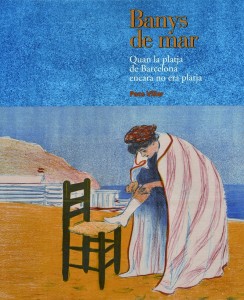Banys de mar
Paco Villar
Barcelona City Council
Barcelona 2011
214 pages
In 1989, Paco Villar began to delve into Barcelona’s stories with his articles in El Periódico newspaper about the Casino de l’Arrabassada, l’Avinguda de la Llum, the Café de Marsella and its absinthe legend, and the old cafés. The journalistic seed yielded its fruits over a decade, in what has become a reference work: Historia y leyenda del Barrio Chino [History and Legend of Barcelona’s Red-Light District]. A meticulous researcher, Villar spent another ten years on La ciutat del cafés (1750-1880) [The City of Cafés], the first instalment on the smoke-filled meeting places where city folk socialised.
In Banys de mar [Sea Bathing], our chronicler evokes the morning of 22 November 1990: machines demolished the Sant Miquel Baths, the last vestige of our spa heritage. The Sant Miquel Baths’ competitors had all already “fallen”. At Els Orientals baths, some 30 women clung to the railings, but the police unceremoniously removed them. It was not a good day for bathing: it looked like rain, and as machines razed El Astillero baths and two adjacent restaurants, the ensuing shower left silence, debris and puddles in its wake.
The battle for the beach had begun by the end of the 18th century, when hygienists did away with the puritanical decree which stated that sea bathing was bad for our physical, and especially, moral health. Young indienne-trade workers, most of them from the Maresme area, began to take dips in the small cove known as l’Olla next to Passeig de la Llanterna and on Sant Bertran beach, from Santa Madrona to the foot of Montjuïc. This was the site where the first public baths were opened in 1800. Five years later, the governor of Barcelona, the Marquis of Vallesantoro, permitted women to bathe; limited, of course, to feet and ankles “and no other nudity, as this would lead to outrage”.
The difficult balance between social rituals and the prevailing morality would govern bathing in a city that was growing ever more aware of its Mediterranean nature. Forced to choose between the Apollonian and the Dionysian, the citizens of Barcelona went for the latter. During the mid-19th century, magazines such as Un Tros de Paper, Barcelona Cómica, Lo Nunci or La Tomasa chose beach scenes for their front pages: plump bathers stuffed into textile garb and paraphernalia. The 1857 Municipal Bylaws regulated bathing customs, and la Barceloneta won out over Sant Bertran; extending the port and constructing the breakwater brought the demise of that primitive beach.
Water really flourished in the last three decades of the 19th century: Els Orientals, La Deliciosa and El Astillero opened, and hygiene guides, such as Dr Bataller’s, “to make the most of sea bathing”, were all the rage. The 20th century saw the advent of sports – regattas, rowing, sailing, swimming – and the Club Natació Barcelona swimming club was founded in 1907. The end of the belle époque gave rise to functionality for women’s bathing suits and the opening of the Sant Sebastià baths in 1928 saw the dream of having a worthy spa come true. The beach was a social reality, although in 1930 the prohibition of “La Reina dels Banys de Barcelona” (Barcelona’s Queen of the Baths), sponsored by the Imatges weekly, put paid to Sant Sebastià’s aspirations of emulating Deauville. In Josep Maria Planes’ opinion, this thwarted undertaking did the city a great service: “It revealed how a grotesquely medieval minority continued to decide the fate of a capital city which had just organised an Exhibition that had garnered worldwide admiration.” Banys de mar, by Paco Villar, gives us another take on the biography of a city which, while it perhaps once walked the tightrope between cosmopolitism and tradition, now swings, in precarious balance, between its traditional roots and the politically correct progressivism promoted by the Barcelona tourist brand.




